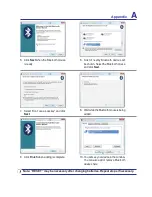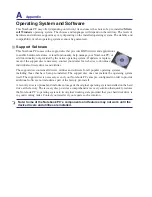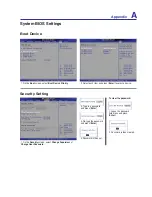
Appendix
A
Glossary (Cont.)
Kensington
®
Locks
Kensington
®
locks (or compatible) allow the Notebook PC to be secured usually using a metal cable and
lock that prevent the Notebook PC to be removed from a fixed object. Some security products may also
include a motion detector to sound an alarm when moved.
Laser Classifications
As lasers became more numerous and more widely used, the need to warn users of laser hazards became
apparent. To meet this need, laser classifications were established. Current classification levels vary from
optically safe, requiring no controls (Class 1) to very hazardous, requiring strict controls (Class 4).
CLASS 1:
A Class 1 laser or laser system emits levels of optical energy that are eye-safe and consequently
require no controls. An example of this class of laser system is the checkout scanning device found
in most grocery stores or lasers used in optical drives.
CLASS 2 & CLASS 3A:
Class 2 and Class 3A lasers emit visible, continuous-wave (CW) optical ra-
diation levels slightly above the maximum permissible exposure (MPE) level. Although these lasers
can cause eye damage, their brightness usually causes observers to look away or blink before eye
damage occurs. These lasers have strict administrative controls requiring placement of signs warning
personnel not to stare directly into the beam. Class 3A lasers must not be viewed with optically-aided
devices.
CLASS 3B:
Class 3B lasers, and Class 3A lasers with outputs of 2.5mW, are hazardous to personnel
who are within the beam path and look at the beam source directly or by specular reflection. These
lasers cannot produce hazardous diffuse reflections. Personnel working with these lasers should wear
appropriate protective eye wear during any operation of the laser. Class 3B lasers have both admin-
istrative and physical controls to protect personnel. Physical controls include limited access work
areas. Administrative controls include special warning signs posted outside the entrances to the laser
work spaces and lights outside the entrances that warn personnel when the lasers are in use.
CLASS 4:
Class 4 lasers are high-power lasers that will cause damage to unprotected eyes and skin
through intra-beam viewing and specular or diffuse reflections. Consequently, no personnel should
be in a room where a Class 4 laser is operating without proper eye protection.
PCI Bus (Peripheral Component Interconnect Local Bus)
PCI bus is a specification that defines a 32-bit data bus interface. PCI is a standard widely used by ex
-
pansion card manufacturers.
POST (Power On Self Test)
When you turn on the computer, it will first run through the POST, a series of software-controlled diag
-
nostic tests. The POST checks system memory, the motherboard circuitry, the display, the keyboard, the
diskette drive, and other I/O devices.
Содержание W7F
Страница 1: ...Notebook PC Hardware User s Manual VOL E3276 Jun 2007 ...
Страница 4: ... Contents ...
Страница 10: ...10 1 Introducing the Notebook PC ...
Страница 34: ...34 4 Using the Notebook PC ...
Страница 50: ...50 4 Using the Notebook PC ...
Страница 81: ...Appendix A ...














































